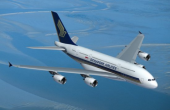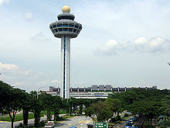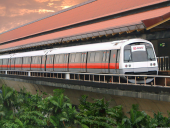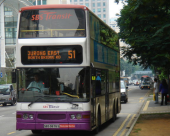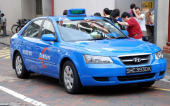
|

|
Conference Location
 Singapore, officially the Republic of Singapore, is an island country off the southern tip of the Malay Peninsula, 137 kilometres (85 mi) north of the equator, in the Southeast Asian region of the Asian continent. It is separated from Malaysia by the Straits of Johor to its north, and from Indonesia's Riau Islands by the Singapore Strait to its south. A city-state, Singapore is the world's fourth leading financial centre and a cosmopolitan world city, playing a key role in international trade and finance. Singapore has a diverse population of close to 5 million people made up of Chinese, Malays, Indians, Caucasians, and Asians (of various descent). It has the sixth-highest percentage of foreigners in the world (42%), who make up 50% of the service sector. The country is the second most densely populated in the world after Monaco.
Singapore, officially the Republic of Singapore, is an island country off the southern tip of the Malay Peninsula, 137 kilometres (85 mi) north of the equator, in the Southeast Asian region of the Asian continent. It is separated from Malaysia by the Straits of Johor to its north, and from Indonesia's Riau Islands by the Singapore Strait to its south. A city-state, Singapore is the world's fourth leading financial centre and a cosmopolitan world city, playing a key role in international trade and finance. Singapore has a diverse population of close to 5 million people made up of Chinese, Malays, Indians, Caucasians, and Asians (of various descent). It has the sixth-highest percentage of foreigners in the world (42%), who make up 50% of the service sector. The country is the second most densely populated in the world after Monaco.
|
Even before independence in 1965, Singapore was one of the richest states in East Asia due to its strategic location as a port. Its GDP per capita in 1965 was $511, the third highest in East Asia after Japan and Hong Kong. After independence, foreign direct investment and a state-led drive for industrialization based on plans by former Deputy Prime Minister Dr. Goh Keng Swee created a modern economy focused on industry, education and urban planning. |
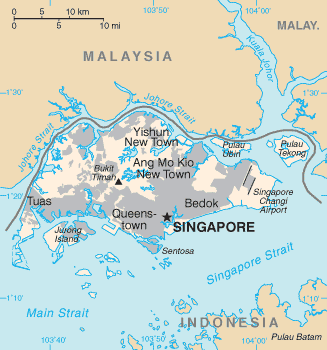
|
Singapore is the fourth wealthiest country in the world in terms of GDP (PPP) per capita, and the twentieth wealthiest in terms of GDP (nominal) per capita. Despite Singapore's small size, it has the world's ninth largest foreign reserves. Today, the port of Singapore continues to be among the top five busiest ports in the world. The Singapore Armed Forces are the most technologically advanced and well-equipped in the region. Singapore is currently the fastest growing economy in the world, where economic growth for the first half of Year 2010 reached 17.9%.
History
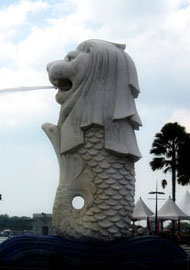
|
The first records of settlement in Singapore are from the 2nd century AD. The island was an outpost of the Sumatran Srivijaya empire and originally had the Javanese name Temasek ('sea town'). Between the 16th and early 19th centuries, Singapore was part of the Sultanate of Johor. In 1613, Portuguese raiders burnt down the settlement at the mouth of Singapore River and the island sank into obscurity for the next two centuries. On 29 January 1819, Thomas Stamford Raffles landed on the main island in Singapore. Spotting its potential as a strategic trading post for Southeast Asia, Raffles signed a treaty with Sultan Hussein Shah on behalf of the British East India Company on 6 February 1819 to develop the southern part of Singapore as a British trading post and settlement. |
|
Until 1824, Singapore was still a territory controlled by a Malay Sultan. It officially became a British colony on 2 August 1824 when John Crawfurd, the second resident of Singapore, officially made the whole island a British possession by signing a treaty with Sultan Hussein Shah in which the Sultan and the Temmenggong handed it over to the British East India Company. In 1826 it became part of the Straits Settlements, a British colony. By 1869, 100,000 people lived on the island. |
|
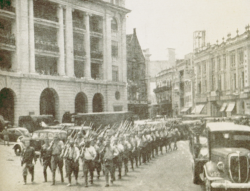
|
During World War II, the Imperial Japanese Army invaded Malaya, culminating in the Battle of Singapore. The British were defeated in six days, and surrendered the supposedly impregnable fortress to General Tomoyuki Yamashita on 15 February 1942. The surrender was described by British Prime Minister Winston Churchill as "the worst disaster and largest capitulation in British history". The Sook Ching massacre of ethnic Chinese after the fall of Singapore claimed between 5,000 and 25,000 lives.The Japanese renamed Singapore Shōnantō (昭南島?), from Japanese "Shōwa no jidai ni eta minami no shima" ("昭和の時代に得た南の島"?), or "southern island obtained in the age of Shōwa", and occupied it until the British repossessed the island on 12 September 1945, a month after the Japanese surrender. |
|
Following the war, the British government allowed Singapore to hold its first general election, in 1955, which was won by a pro-independence candidate, David Marshall, leader of the Labour Front party, who became Chief Minister. |
|
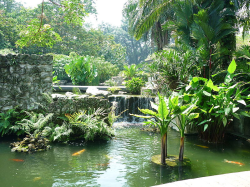
|
Elections were held on 30 May 1959 with the People's Action Party winning a landslide victory. Singapore eventually became a self-governing state within the Commonwealth on 3 June 1959, and Lee Kuan Yew was sworn in as the first prime minister. Then Governor of Singapore, Sir William Allmond Codrington Goode, served as the first Yang di-Pertuan Negara until 3 December 1959. He was succeeded by Yusof bin Ishak, later first President of Singapore. |
|
Singapore declared independence from Britain unilaterally in August 1963, before joining the Federation of Malaysia in September along with Malaya, Sabah and Sarawak as the result of the 1962 Merger Referendum of Singapore. Singapore was expelled from the Federation two years after heated ideological conflict between the state's PAP government and the federal government in Kuala Lumpur. |
|
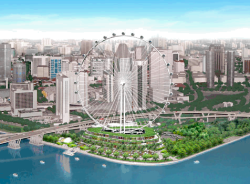
|
Singapore officially gained sovereignty on 9 August 1965. Yusof bin Ishak was sworn in as President, and Lee Kuan Yew became the first prime minister of the Republic of Singapore. In 1990, Goh Chok Tong succeeded Lee as Prime Minister. During his tenure, the country faced the 1997 Asian Financial Crisis, the 2003 SARS outbreak, and terrorist threats posed by Jemaah Islamiyah. In 2004, Lee Hsien Loong, eldest son of Lee Kuan Yew, became the third prime minister. Among his more notable decisions is the plan to open casinos to attract tourism. |
Parts of this text were copied from 
Conference Venue
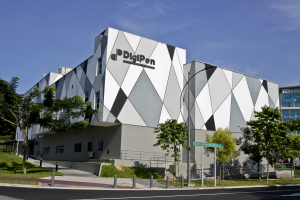 For the exact location, see the maps below. |
DigiPen Institute of Technology Singapore is located in the PIXEL Building at 10 Central Exchange Green, a newly constructed road just off Portsdown Road in the Buona Vista area. The building is visible from Portsdown Road and is just a block or two from the new Fusionopolis building complex. |
How to reach Singapore and the conference venue 
By Plane |
After clearing customs and immigration at the airport you can take the Changi Airport Skytrain which operates between Terminals 1, 2 and 3, and from there you can reach Singapore proper using the the Mass Rapid Transit (MRT) network, with Changi Airport Station located underground between Terminal 2 and Terminal 3 and directly accessible from both terminals. A direct, one-train service to the downtown and western parts of Singapore was initially in operation when the station opened on 8 February 2002 (then accessible only via Terminal 2). This was replaced by the current shuttle service between Changi Airport Station and Tanah Merah Station on 22 July 2003,when it was found that few passengers actually use this route, compared to the number of commuters who need to travel from the city to Tampines and Pasir Ris. Cross-platform transfers are therefore necessary at Tanah Merah Station to connect to the rest of the network. Buses use bus terminals in the basement level of the three main terminals, as well as a bus-stop along Airport Boulevard which is connected by a sheltered walkway to the Budget Terminal, making a loop starting from Terminal 3 to Terminal 1, 2, and then the Budget Terminal, and back to their destination of origin. Taxi stands are within the arrival halls of the three main terminals and just outside the Budget Terminal. |
By Metro |
MRT System, see above at Airport. |
By Bus |
Take the MRT to Buona Vista. From there (North Buona Vista Road bus stop directly outside the station), you can take bus 191 to Portsdown Road and get off at stop B10 (Opposite Fusionopolis). The bus ride only takes a few minutes and stops quite close to the school. |
By Taxi |
Turn left (if you are coming from the east) off of North Buona Vista Road onto Portsdown Road (you'll see a sign for "Temasek Club" as well). You will pass Fusionopolis on your right, while you should follow the road as it curves to the left a bit and then again to the right. You will see the school ahead (Pixel, as indicated on the map). Turn left onto Central Exchange Green and immediately left again to enter the carpark for the school. |
By Car |
See above (Taxi) for driving directions. |
Singapore Public Transportation Card
 
|
Stations are divided into two areas, paid and unpaid, which allow the rail operators to collect fares by restricting entry only through the fare gates, also known as access control gates.[72] These gates, connected to a computer network, are capable of reading and updating electronic tickets capable of storing data, and can store information such as the initial and destination stations and the duration for each trip. General Ticketing Machines sell tickets for single trips or allow the customer to purchase additional value for stored-value tickets. Tickets for single trips, coloured in green, are valid only on the day of purchase, and have a time allowance of 30 minutes beyond the estimated travelling time. Tickets that can be used repeatedly until their expiry date require a minimum amount of stored credit. As the fare system has been integrated by TransitLink, commuters need to pay only one fare and pass through two fare gates (once on entry, once on exit) for an entire journey, even when transferring between lines operated by different companies.[73] Commuters can choose to extend a trip mid-journey, and pay the difference as they exit their destination station. |
BEWARE

When you bring your PC or other equipment to Singapore be aware that different plugs are needed. (see an overview of world plugs here)
- That your VISA requirements are OK. See the Fees Page for more information.
Singapore Maps
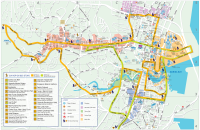
|

|
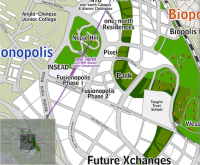
|
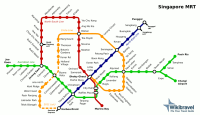
|
Click on the above maps for an expanded view
Useful links (more to follow)
Check back for further updates here: 


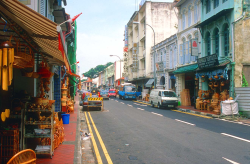
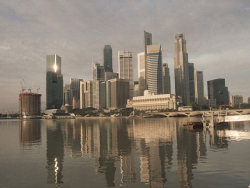
 Tel: +65 6577 1900
Tel: +65 6577 1900 Fax: +65 6577 1908
Fax: +65 6577 1908
